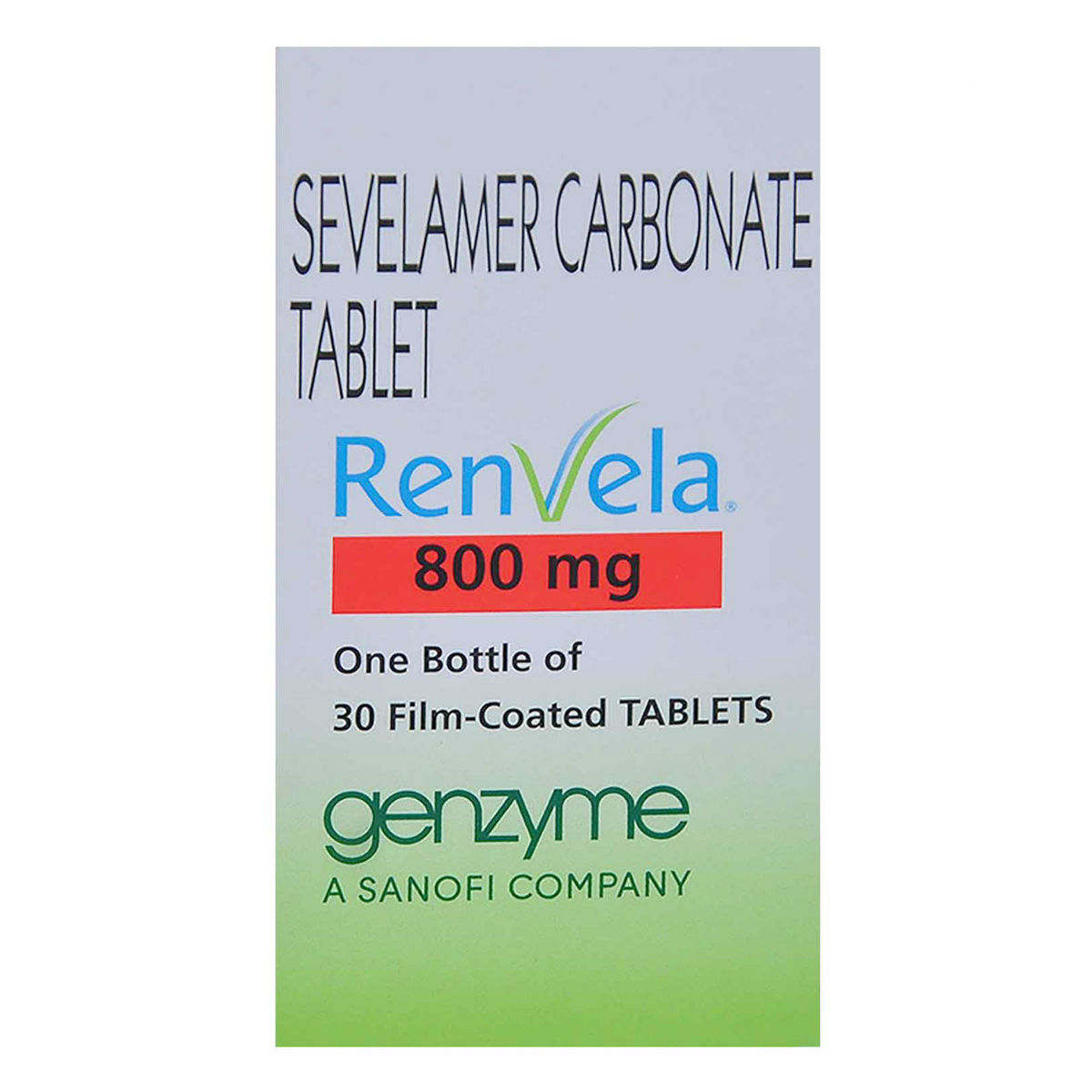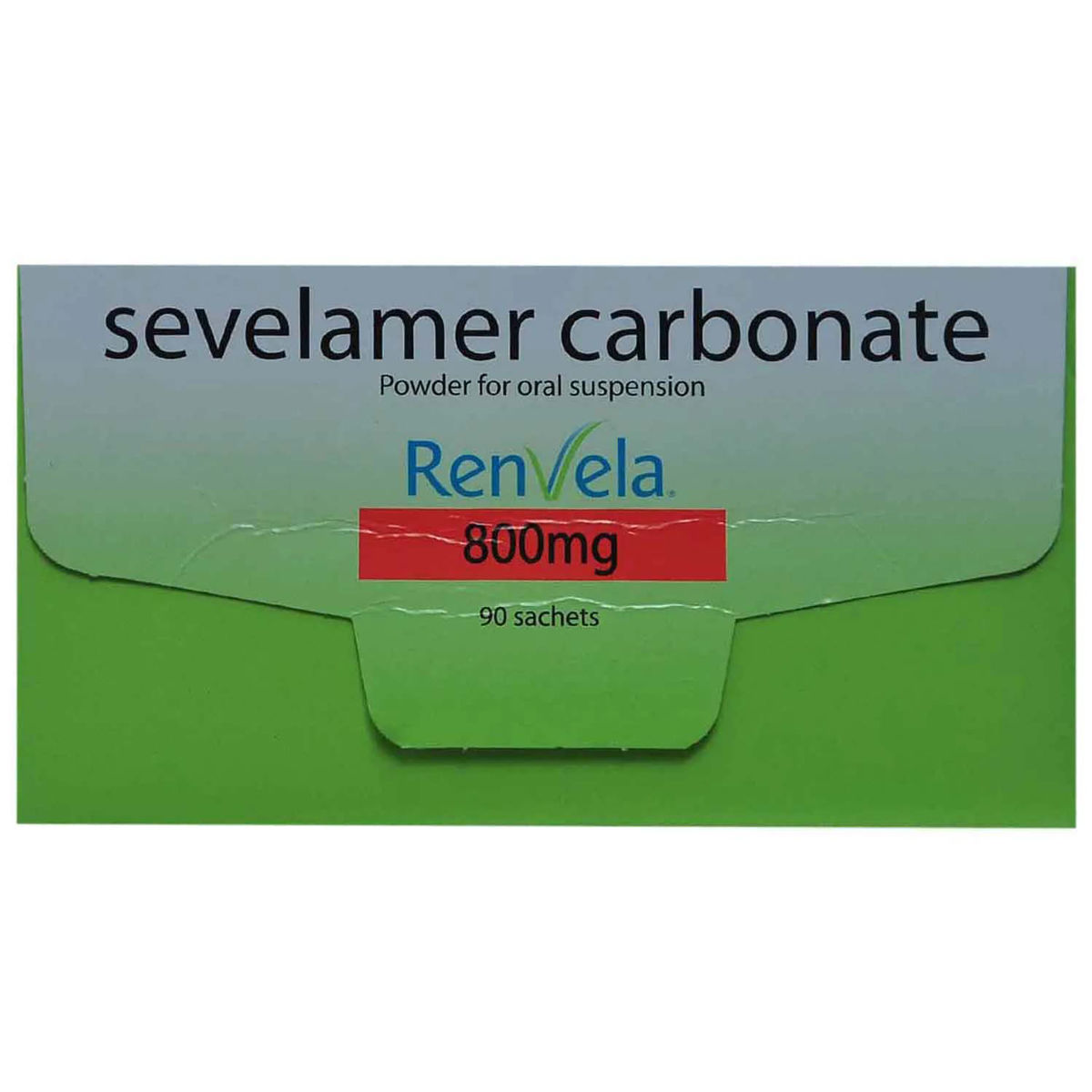Sevelamer
About Sevelamer
Sevelamer is used to control high phosphate levels in the body (hyperphosphataemia) in adult patients on dialysis (a blood clearance technique), patients undergoing hemodialysis (using a blood filtration machine), and patients with chronic kidney disease. It is also used for the treatment of bone disease.
Sevelamer contains sevelamer that works by binding phosphate in the gastrointestinal tract and decreasing absorption. It effectively reduces excess phosphate levels in the blood, prevents the unsafe build-up of phosphate in your body, helps keep your bones strong, and decreases the risk of heart disease and strokes.
Take Sevelamer exactly as directed by your doctor. The most common side effects of Sevelamer are vomiting, upper abdominal pain, nausea, diarrhoea, stomach ache, indigestion, and flatulence. However, if the side effects persist, contact your doctor.
The use of Sevelamer is restricted in persons with a known history of allergic to any of the ingredients present in this medicine, have low levels of phosphate in their blood, and have a bowel obstruction. Sevelamer contains lactose (milk sugar). If you have an intolerance to some sugars, contact your doctor before taking Sevelamer. Tell your doctor if you are facing swallowing problems, motility (movement) in your stomach and bowel, being sick frequently, active inflammation of the bowel, have undergone major surgery on your stomach or bowel, or have serious inflammatory bowel disease. If you are pregnant or breastfeeding, please consult your doctor before taking Sevelamer.
Uses of Sevelamer
Medicinal Benefits
Sevelamer belongs to a group of medications called phosphate binder, which works by binding phosphate in the gastrointestinal tract and decreasing its absorption. This lowers the phosphate concentration in the body. It effectively reduces excess phosphate levels in the blood, prevents the unsafe buildup of phosphate in your body, helps keep your bones strong, and decreases the risk of heart disease and strokes. Sevelamer controls hyperphosphataemia (high blood phosphate levels) in adult patients on dialysis (a blood clearance technique), patients undergoing hemodialysis (using a blood filtration machine) or peritoneal dialysis (where the fluid is pumped into the abdomen and an internal body membrane filters the blood), and patients with chronic kidney disease.
Directions for Use
Storage
Side Effects of Sevelamer
Headache
Diarrhoea
Stomach upset
Constipation
Drug Warnings
You should avoid taking Sevelamer if you are allergic to Sevelamer. Speak to your doctor if you have swallowing disorders, digestive tract surgery, severe constipation, have undergone major surgery on your stomach or bowel, or have serious inflammatory bowel disease. It should be used with caution if you are pregnant or planning to become pregnant. Sevelamer should not be recommended for breastfeeding mothers as it passes into breast milk. Avoid alcohol consumption while taking Sevelamer as it might cause unpleasant side effects. The safety and effectiveness of children under six years of age have not been established, so a Sevelamer should not be given to them. Sevelamer contains lactose (milk sugar). If you have an intolerance to some sugars, contact your doctor before taking Sevelamer. Regular monitoring of serum phosphate levels, vitamin D, A, E, K, and folic acid is advised while taking Sevelamer.
Drug Interactions
Drug-Drug Interactions: Sevelamer interacts with antibiotics (ciprofloxacin), immunosuppressive agents (mycophenolate), thyroid medications (levothyroxine), and medication used to treat bladder cancer (erdafitinib).
Drug-Food Interactions: Avoid taking high-phosphate additives and alcohol as this makes it harder for your body to absorb Sevelamer and increases side effects. Using Sevelamer together with multivitamins with minerals may decrease the effects of multivitamins with minerals. So, Multivitamins with minerals should be administered at least 4 hours before Sevelamer.
Drug-Disease Interactions: The use of Sevelamer is restricted in people with hypophosphatemia (low phosphate level in blood), bowel obstruction and perforation, and severe liver disease.
Drug-Drug Interactions Checker List:
Safety Advice

Alcohol
cautionYou are recommended to avoid alcohol consumption while taking Sevelamer to avoid unpleasant side effects.

Pregnancy
cautionSevelamer is Category C pregnancy medicine. Please consult your doctor if you have any concerns; your doctor will prescribe you Sevelamer only if the benefits outweigh the risks.

Breast Feeding
cautionThe safety of Sevelamer has not been established in breastfeeding women. Please consult your doctor if you have any concerns regarding this; your doctor will decide whether the Sevelamer can be given to breastfeeding mothers or not.

Driving
safe if prescribedSevelamer has no or negligible influence on the ability to drive or operate any machinery.

Liver
cautionSevelamer should be used with caution in patients with liver impairment/liver disease. Please consult your doctor if you have a liver impairment or any concerns regarding this.

Kidney
safe if prescribedDose adjustment may be needed. Sevelamer should be used with caution in patients with kidney impairment/kidney disease. Please consult your doctor if you have kidney impairment or any concerns regarding this.

Children
cautionFor children, SEVELAMER is available in pouches for oral suspension. Please consult your paediatrician for further information. The paediatrician will decide the dose of this medicine.
Habit Forming
Diet & Lifestyle Advise
Take fresh fruits, vegetables, rice, milk, un-enriched corn and rice cereals, and soda without phosphate additives in your regular diet.
Avoid or limit high phosphorus addictive foods (processed meats, instant puddings, sauces, spreadable cheeses, and beverage products).
Avoid intake of alcoholic beverages with Sevelamer as it can make you dehydrated and may increase the side effects.
Make sure you drink plenty of fluids. This will help you clear out the extra phosphate and will help you overcome some.
Sevelamer is preferably taken with meals as it can bind to dietary phosphate and prevent its absorption into the bloodstream. Drink it with a full glass of water.
Do not stop taking the Sevelamer dose until your doctor says so.
Do not use Sevelamer if you have a history of bowel obstruction.
Special Advise
Regular monitoring of serum phosphate levels, vitamin D, A, E, K, and folic acid is recommended while taking Sevelamer.
Patients Concern
Disease/Condition Glossary
Hyperphosphatemia: Hyperphosphatemia is defined as an increased phosphate level in the blood. This condition is often a complication of chronic kidney disease. Phosphate is an important electrolyte. It strengthens your bones and teeth and produces energy. When phosphate levels increase in the blood due to kidney impairment (the kidney does not remove extra phosphate out of the body), this can cause muscle problems and increase the risk of weak bones, heart attacks, and strokes. It is more common in people with chronic kidney disease and people on dialysis. Symptoms may include itchy skin, red eyes, bone pain, and fractures.
FAQs
Sevelamer is used to control high phosphate levels in the body (hyperphosphataemia)Â in adult patients on dialysis (a blood clearance technique), patients undergoing hemodialysis (using a blood filtration machine), and patients with chronic kidney disease. It is also used for the treatment of bone disease.
No, ciprofloxacin may interfere with the working of Sevelamer; therefore, it should not be taken simultaneously as Sevelamer.
Sevelamer works by holding onto phosphate from the food so that it can pass out of your body. Decreasing blood phosphate levels can help keep your bones strong, prevent unsafe buildup of minerals in your body, and possibly decrease the risk of heart disease and strokes that can result from high phosphate levels.
Yes, constipation is the common side effect of Sevelamer, though it does not occur in everyone. Please consult your doctor if the side effect becomes severe and disturb you.
Yes, serum phosphate levels should be monitored regularly while you are taking Sevelamer. The use of Sevelamer may decrease the levels of vitamin D, A, E, K, and folic acid and hence the levels need to be monitored during the treatment.
No, Sevelamer is a class of medications called phosphate binder used to control the phosphate level in blood. If you stop taking Sevelamer, your phosphate levels may elevate again. Please consult your doctor.
The side effects of Sevelamer include diarrhoea, headache, stomach upset, and constipation. If these side effects persist or worsen, please consult your doctor.
Take Sevelamer for as long as it is prescribed by your doctor. The dose and duration will depend on the response to treatment. Follow your doctor's instructions and do not stop taking Sevelamer on your own.
No, Sevelamer does not contain a steroid. It contains Sevelamer, which belongs to the class of drugs called phosphate binders.
Yes, Sevelamer can be taken with food as it works by binding to phosphate from food. Take it exactly as prescribed by your doctor.
It is important to take Sevelamer as phosphate levels in the blood cannot be controlled in patients undergoing dialysis, especially after a meal. When phosphate level exceeds above the range in the blood, it may cause problems such as red eyes, itchy skin, high blood pressure, bone pain, and also increase the risk of fractures. Sevelamer lowers these increased serum phosphate levels by binding phosphate from food in the digestive tract.
Sevelamer should be avoided by patients who are allergic to it and who have low phosphate levels in blood. Additionally, patients having intestinal obstruction should also avoid taking Sevelamer.
Take Sevelamer for as long as it is advised by your doctor. It lowers your levels of dietary phosphate but does not cure your disease. Therefore, you might need to take it lifelong, as stopping Sevelamer may increase your phosphate levels.
You are recommended to consult your doctor before taking other medicines with Sevelamer to avoid drug interactions.
If you miss a dose of Sevelamer, do not worry. Take it as soon as you remember. But, if it is time for your next dose, skip the missed dose and take your regular dose. Do not take a double dose to make up for the missed dose.



